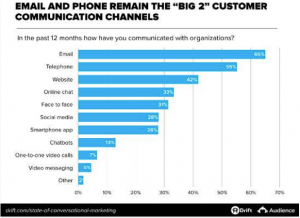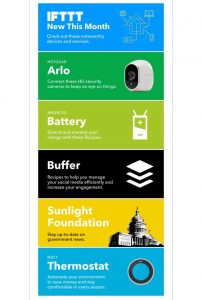You may have heard that email prospecting is a waste of time these days because buyers have plenty of information at their disposal and are more comfortable researching products for themselves. Yet statistics show that a whole lot of cold emails are still getting warm receptions.
A recent survey by the RAIN Group found that 80% of buyers prefer communicating with sellers via email, while a census by Econsultancy showed that email had the highest ROI of any marketing or sales channel.
The fact is, email is still both the most popular and the most profitable way for sales reps to reach out to leads, and it can be hugely effective when done right. To help you receive responses from prospects, we’re breaking down the best practices for writing, sending, and continually perfecting prospecting emails.
Writing strong subject lines
The difference between a good and a bad subject line is the difference between an email that gets read and an email that gets ignored. Here are some tips on how to craft a subject line that encourages leads to open your message.
1. Talk like a real person.
If a subject line sounds like spam, it’s going to be treated as such—either by the prospects’ email service or by the prospects themselves. Be careful not to use any of the words and phrases that often trigger a spam filter, such as the following:
- Best Price
- Winner
- Click Here
- Double Your
- Money Making
- Why Pay More?
Another good way to show you’re not a robot is to use casual slang and a conversational tone. No need to overdo it, but “Hey! Any time to chat about […]?” makes for a friendlier subject line than “Requesting time to discuss […]”
Some sales reps even include intentional misspellings in their subject lines just to prove that they’re human. While that tactic might feel too unprofessional for a lot of people, it shows the lengths that sellers will go to in order to convey authenticity.
2. Be on a first-name basis.
Whenever possible, you should personalize your subject line to include the name of the prospect, the name of the prospect’s company, or both.
Our eyes are naturally drawn to our own names, making personalized subject lines stand out more than generic ones that are sent out en masse. According to MarketingDive, personalizing email subject lines can boost open rates by 50% and increase click-to-open rates by 58%.
3. Try using emojis.
Many sales reps make the mistake of writing dry, overly formal subject lines. An email that hints at something friendly and entertaining inside often has a better chance of being opened up by curious prospects. For example, a report by Experian stated that brands that included emojis in their subject lines achieved a 56% higher open rate than brands that didn’t.
While you shouldn’t go overboard with smiley faces, including an emoji in a subject line can be a simple yet effective way to convey an idea or emotion. Some emojis can also be used in place of words, reducing the number of characters in your subject line. Speaking of which . . .
4. Keep it nice and short.
Brevity is the soul of prospecting email subject lines.
For starters, subject lines that are too long can get cut off mid-sentence when viewed on a smartphone. But even prospects who aren’t checking their email on a mobile device are inclined to pay more attention to a subject line that’s short and to the point.
An analysis by Leadium concluded that subject lines with no more than four words performed best. While not every line can be reduced to that degree, it’s helpful to have this benchmark as a rough target.
The perfect subject line should be friendly, authentic, addressed to the prospect by name, and as short as possible.
Crafting an engaging email body
A strong subject line is the trick to boosting your open rates. But when it comes to getting a prospect to actually read your email and complete your call to action, it’s the body of the email that counts.
To really engage a reader, the body of your prospecting email should perform well in a few key areas.
5. Get personal.
At a minimum, the body of an email should include the prospect’s first and last name, job title, and company. A good prospecting email should delve even deeper by also touching on the finer details of the recipient’s personal or professional life.
For example, you might mention the prospect’s employer and something topical about their business to show your interest in their work. Look up news about the company, read their recent press releases, and check the blog posts on their site to find a good conversation starter.
You could also research a prospect’s LinkedIn page or social media accounts and find a noninvasive way to reference his or her alma mater, coworkers, geographic region, closest competitors, recent achievements or awards, or personal or professional areas of interest, as well as any news or data relevant to the prospect’s industry or profession.
6. Tell recipients what’s in it for them.
When it comes to your pitch, focus less on explaining how your product or service works, and more on how it can work for the prospect and their company. This focus not only makes a prospecting email feel more personalized but also helps the potential buyer envision exactly how your product would make their lives easier.
Use language that makes it clear how your product or service could benefit the potential customer you are trying to reach. For example, instead of saying, “Our software helps large companies organize important documents,” you might give readers concrete examples of what your product organizes: “You’ll never have to waste time trying to track down missing contact info or a misplaced memo.”
Another key way to illustrate your product’s benefits is to link to some applicable case studies in your email. Explaining how you can solve a prospect’s specific problem makes your product seem appealing, while linking to case studies documenting similar successes gives it credibility.
7. Hit the word count sweet spot.
The body of the email, much like the subject line, should never be too long. However, you also don’t want to keep it so short that the reader doesn’t have all of the information that they need to see how your product could benefit them. The key is finding that perfect “Goldilocks” length that fits between two extremes.
According to one analysis of over 40 million emails, the email body that’s “just right” is between 50 and 125 words in length. The study found that messages of 75 to 100 words achieved the best response rates, with 51% of recipients replying. Messages with more than 125 words or fewer than 50 had response rates that dipped below 50%, and there was a very significant drop-off for emails that were over 2,000 words in length or just 10 words or fewer.
In short, prospects seem to respond best to emails that are much briefer than the average blog but still longer than the average tweet.
8. Focus on formatting for mobile.
With prospecting emails, what you include in your message is just as important as how that content is presented.
Over 70% of mobile users say they will delete an email if it doesn’t look good on mobile. Pair that with the fact that roughly 35% of people use smartphones to check business emails and it’s clear why sales reps should make sure to properly format emails for mobile devices. Check out this resource to learn how to ensure that your prospecting emails display correctly.
The body of a prospecting email is where you really get personal with the prospect, both in terms of your conversation starter and in terms of your customized sales pitch. Just try to keep the length of your message manageable, and be sure it looks good on a smartphone screen.
Knowing when and how to send follow-up emails
Despite all the effort you put into your prospecting message, industry averages show that most cold emails are still met with a cold shoulder.
That said, you shouldn’t let disappointing response rates deter you from following up. In fact, you might be surprised by just how much your persistence can pay off.
9. Keep sticking your foot in the door.
A lot of sales reps are afraid that sending additional emails to recipients who never responded to an initial message will come off as desperate or overly aggressive. While you don’t want to be pushy or pleading, there’s data to support the idea that sending multiple follow-ups can be effective.
A study by Iko System found that the first follow-up email sent by salespeople had an average reply rate of 18%, which gradually declined to 10% for the fifth follow-up. However, the reply rate jumped back up to a whopping 27% for the sixth follow-up email, and the seventh email was nearly as effective as the first, at 17%.
When it comes to follow-ups, it seems the sixth time’s a charm. So although keeping up a one-sided conversation may feel awkward, there is a lot of potential upside to sending multiple emails to a nonresponsive prospect.
10. Vary your approach.
Not all recipients should receive the same amount or type of follow-up emails. The best practices for follow-ups will vary, depending on the level of engagement the prospect has shown:
- Prospects who replied to at least one email but then went cold should keep getting follow-ups until you get another response. Try to get these prospects to agree to a call, since their email communications are so spotty.
- Prospects who have never responded but have opened an email or clicked on a link have shown enough interest to make a serious pursuit worthwhile. In each follow-up, try out a new pitch or address a different pain point, and keep it up until you hit on one that gets a reply.
- Prospects who haven’t interacted at all with an email don’t merit more than six or seven follow-up emails, unless they start to engage.
Every prospect is worth sending multiple follow-ups, but the ones who have demonstrated some degree of interest are the ones to prioritize and really keep after.
11. Taper down your frequency.
If a prospect doesn’t reply to your first email, taper off the frequency of follow-up messages.
The first follow-up email should always be sent within two or three business days of the initial email. After that, add another day of waiting before sending each subsequent follow-up. Once you’ve gotten to your fourth follow-up, you can start sending one a week until they respond or you feel it’s time to move on.
The important thing is not to give up too early. Keep trying new approaches in a steady yet staggered stream of follow-up emails, keeping in mind that you sometimes don’t get a response until the sixth or seventh attempt.
Measuring the success of your prospecting emails
The tips we’ve provided are a good starting point for prospecting emails, but you may find that some approaches work better than others. Determine the best practices for your prospects by tracking the performance of your emails with software and testing.
12. Use your CRM system to measure success.
If you use a CRM system like Sell to send your prospecting emails, you can monitor the performance of messages through the tool. CRM systems not only allow you to see key metrics—such as opens and clicks—for individual emails but also let you review data for all emails to gauge overall performance. Sell software also features a Communications Center, which lets you review all sent emails at once to see which prospects have opened your messages and which ones still haven’t. You can also find information detailing exactly when and how many times an email was open or clicked on.
13. Run some split tests.
Baseball fans like to analyze a player’s “splits”: how well they hit against left-handed versus right-handed pitching, at home versus on the road, and so on. Similarly, split or A/B testing involves sending out two versions of an email with one crucial difference between the pair and then analyzing both to see which performs better.
To find ways to improve your email response rates, conduct A/B tests that vary the following factors:
- Subject line
- Intro
- Pitch
- CTA (Call to action)
- Signature
- Day of the week an email is sent
- Time of day an email is sent
Keep in mind that different variables should be judged by different metrics. For example, you should look at open rates when comparing two different subject lines, while response rates are a better judge of what works best in the body of the email.
14. Keep adjusting.
The testing process for prospecting emails is one that should be continually refined, since experimenting with new ideas is the only way to know what works.
Keep tweaking your emails to find what gets the best response rates. Just because you’ve determined that CTA #1 works better than CTA #2, for example, you haven’t necessarily proved that CTA #1 is the best available option. Take the better of the two, and put it in another split test against a different CTA, and so on, to find out whether there are other variations that can deliver even better response rates.
Testing a variety of different prospecting emails while using a CRM system to monitor and record the results is the best method for improving their effectiveness and boosting your response rates.
Getting your prospect’s attention in a crowded world
Prospecting has had to evolve due to a number of factors. Not only have buyers gotten better at shopping for themselves, but there are more and more sales and marketing channels competing for their time and attention.
In order to cut through all the noise and make a connection, the cold emails of today require lots of optimization for length and detailed customization for individual prospects. And even then, it often takes multiple follow-up emails and endless experimentation to get the response rates you want. This process takes work, but putting in the effort will lead to more responses from high-quality prospects.
Digital & Social Articles on Business 2 Community
(72)





